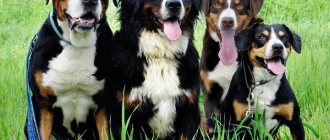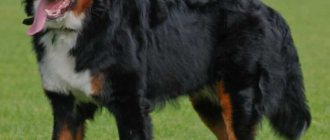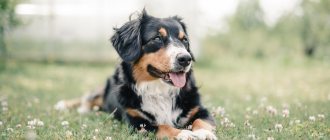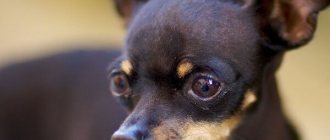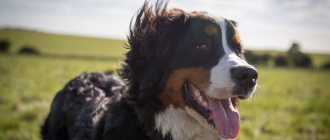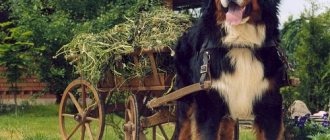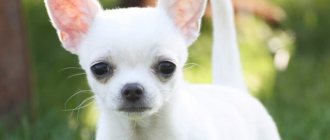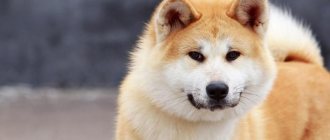Many people have pets, dogs are one of the popular ones. The Bernese Mountain Dog breed comes from Switzerland and is loved by many dog breeders. It was bred to help shepherds, but today the animal is loved for its friendliness and protective qualities. You can keep such a pet not only in a house, but also in an apartment.
General description. A shepherd with the soul of an aristocrat
The Bernese Mountain Dog is a Molosser, a large breed of dog that descended from Egyptian and Assyrian baiting dogs. However, over almost 2 thousand years of formation, they completely lost their hunting instinct.
The Mountain Dog is also called the Bernese Shepherd or Mountain Cattle Dog. Translated from German, “hund” means dog, and the word “senn” meant Swiss shepherds.
But the Bernese Mountain Dogs did not limit themselves to just herding. They were also used for transporting goods and as guards. Although dogs cannot be guard dogs due to their good nature, they are excellent guard dogs. One formidable appearance can scare off ill-wishers.
Progress conquered the highlands slowly. Therefore, Bernese Shepherds transported milk and other products in special carts.
The Bernese Mountain Dog can pull 10 times its weight - up to 500 kg.
Dogs were created to work. Labor is their favorite thing. They are happy to pull the harness and help with all household chores. They need to feel useful. Otherwise the animals will wither away.
Bernese are adapted to life in harsh climates. Powerful bones, strong paws, and thick hair allow them to easily move along mountain ranges and endure cold weather.
Despite their “rural” origins, Bernese Mountain Dogs are not without aristocratic manners. They are unobtrusive and detect the slightest changes in the owner’s mood and well-being.
Even the appearance of a shepherd dog smacks of nobility. You can endlessly admire the light gait, proudly raised head and tricolor coat shimmering in the sun.
What care is required
Berns are equipped with a developed undercoat, which protects them from both low and high temperatures. Breeders strongly recommend trying to protect the dog from scorching sun rays and overload during this period, but they are also naturally resilient. Dogs love to sleep on snow crust and rarely spend time in the kennel.
Bernese Mountain Dog puppies in the photo
An excellent place to keep them is an aviary. Moreover, insulation of the booth is only necessary if the animal is sitting on a chain. In this case, walks should be more frequent and longer. Once every day for at least two hours.
A dog will feel fine on a leash if the chain allows it to move within an area of at least 10 square meters.
The apartment mountain dog requires walking twice a day. As for puppies, it all depends on age. All walks must be accompanied by active jogging and games.
Origin of the Mountain Dog. A history spanning two millennia
The Bernese Mountain Dog breed dates back more than 2 thousand years. It was not possible to establish exactly from whom the dogs originated. It is most likely that their ancestor was the Tibetan mastiff.
The ancestors of the Berns came to Europe along with the Roman legionnaires. They took root in the area of the Gotthard Pass in the Alps.
The ancient origin of the breed is confirmed by excavations by Herman Kremer. During an expedition near Zurich, he came across a site of the Helvetii - the ancient Swiss.
An archaeologist has found the skulls of dogs similar to the dogs brought by the Romans. Kremer suggested that these were the ancestors of the Sennenhunds.
Subsequently, the animals were formed in isolation: without admixtures of the blood of other dogs.
At the end of the 15th century, the Berns were almost destroyed. In 1489, the burgomaster of Zurich issued an order - the peasants were to kill all large dogs. Allegedly, they spoiled the vineyards of the feudal lords. But the people rebelled and executed the ruler.
Over their long history, Bernese Mountain Dogs have changed their name several times. At first, they, like all large herding dogs, were called hut dogs. Later, the dogs were nicknamed Dürrbachlers, since the pets were most often found in the vicinity of the Dürrbach farm.
Today's name appeared at the beginning of the 20th century. The first word was fixed in the name of the breed from the canton (city) of Bern. This is how the breeders emphasized the difference between the Bernese and other Sennenhunds.
The struggle for recognition of the breed began in 1900. The battle turned out to be long: the dogs were included in the international classification in 1981, and the standard was adopted in 1990.
Until 1907, only conditional boundaries were adhered to in breeding Berns. Breeders from the city of Dürrbach were concerned about the safety of the breed. Just 3 years later, in 1910, they brought over a hundred representatives to the exhibition.
In the mid-20th century, serious problems arose in the breed. They appeared due to long isolated development and frequent matings. To “refresh” the blood, the owners began crossing Bernese Mountain Dogs with Newfoundlands. This helped strengthen the genotype.
It is interesting that after 2 generations, not a trace of the Newfoundlands remained in the appearance of the Sennenhunds.
Thanks to their spectacular appearance, strong physique, and calm, easy-going disposition, Bernese Mountain Dogs soon became popular in Switzerland and neighboring countries. In 1936, breeders from Great Britain and the USA drew attention to them. At the same time, an American breeder brought representatives of the Bernese Mountain Dog to the state of Louisiana and registered the breed.
During World War II, breeding Mountain Dogs in Europe was problematic. However, the war had no effect on the breeding of the breed in America.
In 1968, the American Bernese Mountain Dog Club was founded for the first time. At first it consisted of 62 members and 43 dogs. Three years later, the number of participants exceeded one hundred.
Nowadays, burns are practically not used for work purposes. They became companions. Dogs get along well in families with children and the elderly.
We recommend reading: TOP 8 dogs for a private home
Characteristics, abilities, skills
He is owner-oriented and moderately distrustful, but friendly to strangers. Other animals arouse his interest and sympathy. The character of the Bernese Mountain Dog easily accepts education and training techniques. Herding dogs tend to make decisions on their own, rather than wait for a command. This does not characterize them as not smart enough or difficult to train, but speaks about the conditions for the formation of the breed: mountains, meadows, a person is far away, a predator or robber is close, there is no time for a meeting. Bernese Mountain Dog: Breed characteristics include natural intelligence and kindness. This good-natured dog is truly friendly with his owner, which can be seen in every movement. A dog that is lenient and generous, but aware of its power, will reward a powerful, but not cruel, person with obedience. Main advantages:
- easy to train;
- excellent watchman;
- friendly to pets and familiar people;
- Perfect for the role of a family pet.
Standard
Today they adhere to the FCI standard No. 45 of 2003. He places mountain herding dogs in Group 2, Section 3 - Swiss Mountain Dogs.
The description of the Bernese Mountain Dog standard is quite conditional. What comes first is not individual indicators, but a proportional physique and a stable psyche.
At the discretion of the judges, a representative with minor deviations from the standard may participate in breeding and exhibitions if he is healthy and harmonious.
Size
The height of males varies from 64 cm to 70 cm, females - from 58 to 66. Weight also varies greatly: 38 - 50 kg for boys, and 36 - 48 kg for girls.
Frame
Durable, strong, with well-developed muscles. The Bernese Mountain Dog is rather stocky, but not boxy. The chest is deep, ending at the elbows. The stomach is not tucked in.
Head
Large, medium length. Scissor bite. A characteristic feature is “dry” shaves, lack of drooling.
The nose is pure black, without pigmentation. The eyes are brown, almond-shaped. The ears are triangular, slightly rounded at the ends, set high, and hang along the head when the dog is not moving.
Paws
Straight, of sufficient length, parallel to each other. Fingers are gathered into a ball.
Tail
Thick, powerful, pubescent along the entire length. When moving, the Bernese Mountain Dog holds it suspended, slightly lifting the tip upward. The tail should not curl or droop over the back.
Wool
Long, thick, with dense undercoat. It can be straight, with a slight wave.
Color
The main color is black. Above the eyes, on the cheeks, all paws, under the tail, and chest, a brown-red tan is required. There are white markings on the forehead, throat, and chest. It is desirable that they also be on the paws (but not above the middle of the pastern), and the tip of the tail.
The defects for which the Bernese Mountain Dog is disqualified include:
- bifurcated nose;
- atypical color;
- Blue eyes;
- curled tail;
- weak bones.
Feeding
To be healthy, she needs to exercise a lot and stick to a proper diet. The main element of a shepherd's diet is protein. The finished mixture should contain 40%-50% protein obtained from beef, chicken, offal, and in higher quality turkey and veal products.
Find the answer Are you bothered by some problem or question? Enter “Breed” or “Name of the problem” into the form, press Enter and you will find out everything about the issue that interests you.
Portions are selected individually, depending on her activity. If the dog is walked moderately and lives in an apartment, it is fed according to the instructions on the package. To accurately determine the amount of food, use a kitchen scale. For an animal that moves a lot and actively, the diet is increased to 120% of the norm. For older pets, the volume of food is reduced to 70% of the norm or transferred to low-protein food.
In high-quality mixtures, vitamins and microelements are obtained from natural sources, vegetables, seeds, and extracts. If the food is of high quality and the mountain dog gets everything it needs, this is noticeable in the condition of its coat.
Bernese Mountain Dog and similar breeds
The Bernese Mountain Dog is one of the 4 representatives of the Swiss Mountain Dogs. Outwardly they are similar to each other. But there are key differences:
- Bernese Mountain Dogs are the only ones with long, wavy hair;
- the Greater Swiss Mountain Dog is the largest dog, males reach 72 cm in height and weigh 64 kg;
- Appenzeller Mountain Dog is a medium-sized dog, its distinctive feature is its tail curled into a horn;
- The Entlebucher Mountain Dog is the smallest dog of the breed group; the height of males does not exceed 50 cm at the withers.
Nurseries
It is best to purchase a Mountain Dog in specialized places. The nursery will be able to provide future breeders with recommendations on the proper upbringing of the animal and all the necessary documents: the puppy’s pedigree, vaccination data.
The most famous nurseries:
- Durbakhler Club in Moscow;
- Sennenhund of Russia in Moscow;
- Bern House on the Oka River in Ryazan;
- The village of Berntsev in Moscow.
The price of a Greater Swiss Mountain Dog puppy varies around $1,500. Bernese Mountain Dogs are valued at $1,000 and up. The final cost for different types of dogs is determined by several factors: the uniqueness of the breed, body structure characteristics, color, massive size, character, and guarding abilities.
Tendency to diseases, life expectancy
Bernese Mountain Dogs are strong and resilient. Unfortunately, they are prone to numerous diseases:
- cancer – occurs more often than in other breeds, found in more than 50% of pets;
- arthritis, dysplasia of the hip and elbow joints, osteochondrosis of the shoulder - the scourge of large elderly dogs, but in Bernese Shepherds it can develop at 2 - 4 years of age;
- eye pathologies: retinal atrophy, cataracts, entropy, ectropia;
- alopecia;
- eczema.
The average life expectancy of Bernese Mountain Dogs is 10 – 12 years. However, dogs rarely live longer than 8–9 years due to numerous diseases.
Feeding dry food
For the Bernese Mountain Dog, you should select food with a protein content of approximately 18-26%, and a moderate fat content - up to 16%. Food that is too fatty can cause obesity in inactive dogs; in some cases, fatty foods cause diarrhea.
It is important to study the composition, because
Some ingredients, chemical preservatives, and additives may cause an allergic reaction, including itching, watery eyes, and digestive problems.
It should not contain soy, wheat, or corn, especially if your pet has a tendency to allergies.
The presence of sources of fat, for example, chicken and fish, is welcome. The fatty acids these foods are rich in help maintain healthy joints, skin and coat.
Among ready-made food, you should pay attention to dry food for giant breeds of the brands Innova, Canine, Orijen, Evo, Canidae, Eagle Pack, as well as grain-free food. In such feeds, sweet potato is usually used as an alternative source of carbohydrates.
How to care at home
The main problems in caring for the Bernese Mountain Dog are related to the coat. Pets shed all year round, so they are brushed 1-2 times a week. In spring and autumn, shedding is especially intense; dogs have to be brushed every day.
The Bernese Shepherd is fed standard food. The basis of the diet is meat, offal, cereals, vegetables, and dairy products. In order for the bones to form correctly, it is necessary to administer 1 tbsp daily. gelatin, stringy beef, tripe.
You can’t mindlessly stuff your Bernese Mountain Dog with vitamins. This breed develops allergies if there is an overdose of vitamins A, C, E. Any complex must be agreed upon with a veterinarian.
Food is given after walks. Animals need to rest after eating. Otherwise, problems with the gastrointestinal tract will appear: bloating and volvulus.
Otherwise, home care is standard:
- the ears are wiped with a sponge and a special lotion once a week;
- teeth are brushed with a special paste and brush every 7–10 days;
- eyes are regularly examined, nitrous is removed;
- claws are trimmed as they grow; if the dog receives enough physical exercise, they should wear off on their own;
- The skin is checked after every walk - due to the thick fur, ticks may not be noticed.
Puppies must have their dewclaws removed.
They are useless. In this case, the animal easily injures them. Berns prefer cold climates. In the summer, make sure that the pet does not overheat. Due to the long, thick coat, heat strokes often occur.
Bernese Mountain Dogs do best in a private home. They can be kept in an enclosure, but not on a chain.
Berns are also suitable for apartment living. However, they need to be walked at least 2 times a day. Excessive shedding causes problems. You will have to put up with the fact that wool will be everywhere.
Like all Molossians, the Bernese Mountain Dog matures late. A dog is considered a puppy until it is 2 years old. At this time, you should not load the muscles and bones of the animal, for example, force it to drag a heavy harness.
Intense physical activity is also prohibited for adult dogs. You cannot force your Bernese Mountain Dog to run until exhaustion or jump from great heights. This can lead to joint problems.
Comparison of prices for varieties
Having a Sennenhund at home is very prestigious. According to the description, representatives of this mountain dog breed are distinguished by their beauty, intelligence and good nature. It is very pleasant to communicate with such animals. Thanks to these features of dogs, in order to become the owner of such a dog, you will have to pay quite a lot of money. On average, puppies cost between 45 and 55 thousand rubles*.
If someone sells puppies much cheaper, then you should be wary so as not to purchase a cross between breeds. It is recommended to purchase a pet only from trusted breeders, and it is best to go to a nursery for a puppy. There you can truly choose the best representative of this breed.
Guard and guard dogs have always been extremely popular. Most often, people prefer huskies and mountain dogs. These animals are distinguished by their loyal and friendly character, intelligence, and the ability to cope with all kinds of work. In addition, representatives of the breed are not demanding in care and nutrition. They treat children very well.
*Prices are current as of November 2022.
Giants with a kind heart. Features of character and behavior.
The character of the Bernese Mountain Dog can be described in one word – “golden”. These are kind, flexible dogs, without aggression towards other people's animals or children. They try to please people in everything.
The Bernese Shepherd is very attached to the family. Although she loves all members, she chooses only one owner. You cannot leave the dog alone for a long time - he needs to constantly be in the company of people.
The Mountain Dog perceives other pets as a herd that must be protected. The dog gets along well with cats, birds, and rodents.
He rarely shows aggression towards other dogs. Usually cruelty is the result of genetic abnormalities or improper upbringing.
Berna can be left with children without fear. Even if a child abuses the animal, the Mountain Dog will simply walk away. But he will never bite or growl at the baby.
For the Bernese Mountain Dog, the safety of children comes first. More important than the owner's commands. If he believes that his actions could harm the child, the dog will not obey the order.
Bernese Mountain Dogs are friendly but wary of strangers. They will only attack if their owner is in danger.
Bernese Mountain Dogs rarely bark. They only speak up if something out of the ordinary has happened.
Dogs are quite lazy. They get tired quickly. It is important to dose the load correctly and alternate rest with active exercise.
Training
Bernese Mountain Dogs are naturally socialized and easily learn simply through interaction with their owner. If you set specific security and watchdog tasks for your dog, it will be more effective to turn to professionals. If not, then training is possible on your own. Raising a puppy begins from the first day in the house. At two or three months the service qualities of his ancestors are already awakening, and he is ready to learn. You need to exercise regularly, but avoid excessive stress. You should alternate training with games so that the lessons do not become a burden for the dog. Minimum required commands:
“To me” is to be taught from the first days, along with memorizing the nickname; “Fu” - a requirement from the pet to immediately stop any action; “You can’t” is a variation of the “Fu” command, preempting an undesirable action; “Nearby” is important for walking in public places; “Sit” is used as a transition between other commands.
Best Savannah cat (28 photos)
The Sennenhund is a large dog with fairly powerful jaws.
Therefore, it is important to teach your pet not to use its teeth in games with the owner and not to try to knock him down.
Basics of education and training
Raising a Bernese Mountain Dog is easy. The dog is smart, attentive, and tries to please his owner. But since animals remain puppies until they are 2 years old, problems are possible during this period.
Bernas begin obedience training at 5–6 months.
Before he is a year old, he should learn basic commands. Only at 1.5 years, when the psyche is finally formed, do they undergo a general training course. The Sennenhund easily remembers commands. But it is worth considering that this is not a service dog. She tends to make her own decisions. Therefore, you should not expect instant returns and lightning-fast execution of orders.
If desired, the Sennenhund can be taught the basics of protective training or guard duty.
The best method of training a Bernese Mountain Dog is regular rewards, persistence and lack of monotony. Ideally, he will perceive training as a game.
Bernese Mountain Dogs were bred in the Alps to herd livestock. Today dogs are excellent companions. They easily get along with family members and other pets. Unfortunately, due to frequent illnesses, dogs rarely live past 10 years.
Puppies
Choosing a puppy is just the beginning. It is recommended to take the baby away from the mother between the ages of 2 and 6 months.
At the same time, you should provide him with psychological comfort, affection and attention.
At the age of 2 to 4 months, the dog is fed 4–5 times a day, from 4 to 6 months – 3–4 times.
For the normal development of bones and joints of puppies, animals are given sinewy meat, cartilage and tripe.
Immediately after eating, the mountain dog is quickly taken outside so that he can relieve his natural needs.
Scolding a child (and even more so hitting him for piles and puddles) is useless. He does not understand the relationship between swearing and relieving himself in the wrong place. It is better to try to properly organize his regime and praise him after a successful experience. When the shepherd understands that the toilet is outside, he will learn to wait until he goes out for a walk.
Even in puppyhood, starting from 2 months, the Bernese is taught the basic commands: “Ugh!”, “You can’t!”, “Come to me!” This lays the foundation for the dog’s further training.
If the security function is important, then the owner will have to explain to the shepherd the difference between family members and strangers.
Also, from an early age, the puppy is taught to groom and undergo hygiene procedures.
Cozy apartment or country house?
“Berns” love their owners so much that they are ready to live with them in a variety of conditions, but the best option, oddly enough, for these dogs is a cozy, spacious apartment rather than a huge territory. A country house is also suitable, but don’t expect your pet to run around the property all day long - with the inherent laziness of Mountain Dogs, he will spend time in a cozy house or area, close to his family.
Important! You cannot keep a pet of this breed on a chain, he will quickly become bored and may have unpleasant consequences for the future: a soft back, incorrect paw placement, a spoiled character.
